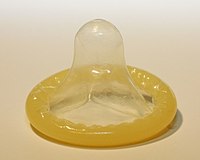
Condom

A condom is a sheath-shaped barrier device, used during sexual intercourse to reduce the probability of pregnancy or a sexually transmitted infection (STI). There are both male and female condoms. With proper use—and use at every act of intercourse—women whose partners use male condoms experience a 2% per-year pregnancy rate. With typical use the rate of pregnancy is 18% per-year. Their use greatly decreases the risk of gonorrhea, chlamydia, trichomoniasis, hepatitis B, and HIV/AIDS. They also to a lesser extent protect against genital herpes, human papillomavirus (HPV), and syphilis. The male condom is rolled onto an erect penis before intercourse and works by blocking semen from entering the body of a sexual partner. Male condoms are typically made from latex and less commonly from polyurethane, or lamb intestine. Male condoms have the advantages of ease of use, easy to access, and few side effects. In those with a latex allergy a polyurethane or other synthetic version should be used. Female condoms are typically made from polyurethane and may be used multiple times. Condoms as a method of preventing STIs have been used since at least 1564. Rubber condoms became available in 1855, followed by latex condoms in the 1920s. They are on the World Health Organization's List of Essential Medicines, the most effective and safe medicines needed in a health system. The wholesale cost in the developing world is about 0.03 to US$0.08 each. In the United States condoms usually cost less than US$1.00. Globally less than 10% of those using birth control are using the condom. Rates of condom use are higher in the developed world. In the United Kingdom the condom is the second most common method of birth control (22%) while in the United States it is the third most common (15%). About six to nine billion are sold a year. The effectiveness of condoms, as of most forms of contraception, can be assessed two ways. Perfect use or method effectiveness rates only include people who use condoms properly and consistently. Actual use, or typical use effectiveness rates are of all condom users, including those who use condoms incorrectly or do not use condoms at every act of intercourse. Rates are generally presented for the first year of use. Most commonly the Pearl Index is used to calculate effectiveness rates, but some studies use decrement tables.:141 The typical use pregnancy rate among condom users varies depending on the population being studied, ranging from 10 to 18% per year. The perfect use pregnancy rate of condoms is 2% per year. Condoms may be combined with other forms of contraception (such as spermicide) for greater protection. Condoms are widely recommended for the prevention of sexually transmitted infections (STIs). They have been shown to be effective in reducing infection rates in both men and women. While not perfect, the condom is effective at reducing the transmission of organisms that cause AIDS, genital herpes, cervical cancer, genital warts, syphilis, chlamydia, gonorrhea, and other diseases. Condoms are often recommended as an adjunct to more effective birth control methods (such as IUD) in situations where STD protection is also desired. According to a 2000 report by the National Institutes of Health (NIH), consistent use of latex condoms reduces the risk of HIV/AIDS transmission by approximately 85% relative to risk when unprotected, putting the seroconversion rate (infection rate) at 0.9 per 100 person-years with condom, down from 6.7 per 100 person-years. Analysis published in 2007 from the University of Texas Medical Branch and the World Health Organization found similar risk reductions of 80–95%. The 2000 NIH review concluded that condom use significantly reduces the risk of gonorrhea for men. A 2006 study reports that proper condom use decreases the risk of transmission of human papillomavirus (HPV) to women by approximately 70%. Another study in the same year found consistent condom use was effective at reducing transmission of herpes simplex virus-2 also known as genital herpes, in both men and women.
